List of National Historic Sites of Canada in Ottawa
This is a list of National Historic Sites of Canada (French: Lieux historiques nationaux du Canada) in its capital city, Ottawa, Ontario. There are 25 National Historic Sites in Ottawa,[1] of which two (Laurier House and the Rideau Canal) are administered by Parks Canada (identified below by the beaver icon ![]() ).[2] The Rideau Canal, which extends to Lake Ontario at Kingston, was designated in 1925 and was the first site designated in Ottawa.[3]
).[2] The Rideau Canal, which extends to Lake Ontario at Kingston, was designated in 1925 and was the first site designated in Ottawa.[3]
There are six other National Historic Sites of Canada located within the National Capital Region, but not within Ottawa proper: the Former Almonte Post Office and Rosamond Woollen Mill in Almonte, the Gillies Grove and House in Arnprior, the Manoir Papineau in Montebello, the Symmes Hotel in the Aylmer sector of Gatineau, and the First Geodetic Survey Station in Chelsea.
National Historic Sites located elsewhere in Ontario are listed at List of National Historic Sites of Canada in Ontario.
This list uses names designated by the Historic Sites and Monuments Board of Canada, which may differ from other names for these sites.
National Historic Sites
| Site | Date(s) | Designated | Location | Description | Image |
|---|---|---|---|---|---|
| Aberdeen Pavilion [4] | 1898 (completed) | 1983 | Ottawa 45°24′0.15″N 75°40′58.16″W / 45.4000417°N 75.6828222°W |
The only large-scale exhibition building in Canada surviving from the 19th century, and also the oldest surviving venue in which the Stanley Cup was contested |  |
| Beechwood Cemetery [5] | 1873 (established) | 2000 | Ottawa 45°26′49″N 75°39′36″W / 45.4469°N 75.6599°W |
An exceptional example of 19th-century rural cemetery design, containing a concentration of mausolea, monuments, and markers of significant importance to the history of Canada, Ontario and Ottawa; the cemetery was declared the national cemetery of Canada in 2009. It has served as the national military cemetery since 1944 and the RCMP's national memorial cemetery since 2004. | .jpg) |
| Billings House [6] | 1829 (completed) | 1968 | Ottawa 45°23′23″N 75°40′20″W / 45.389832°N 75.672235°W |
One of Ottawa's oldest homes, this Georgian homestead was built by Braddish Billings, the first settler of Gloucester Township, where his home formed the nucleus of Ottawa's Billings Bridge area | 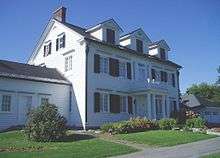 |
| Central Chambers [7] | 1891 (completed) | 1990 | Ottawa 45°25′23.65″N 75°41′42.95″W / 45.4232361°N 75.6952639°W |
A noted example of Queen Anne Revival commercial architecture, with a high profile location on Confederation Square | 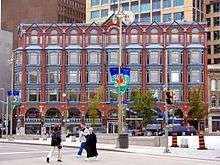 |
| Central Experimental Farm [8] | 1886 (established) | 1997 | Ottawa 45°22′57″N 75°42′49″W / 45.382537°N 75.713654°W |
A rare example of a farm within a city; the site of significant scientific contributions to agriculture |  |
| Château Laurier [9][10] | 1912 (completion of first wing) | 1980 | Ottawa 45°25′32.04″N 75°41′42.39″W / 45.4255667°N 75.6951083°W |
One of Canada's landmark railway hotels, built in the distinctly Canadian Château-style; dubbed the "Third Chamber of Parliament" due to its proximity to Parliament Hill |  |
| Confederation Square [11] | 1939 (established) | 1984 | Ottawa 45°25′26.72″N 75°41′43.8″W / 45.4240889°N 75.695500°W |
The second most important ceremonial centre in Ottawa, after Parliament Hill, with Canada's National War Memorial at its centre and the Valiants Memorial at its periphery, and framed by the Château Laurier, the Government Conference Centre, the National Arts Centre, the Central Chambers, the Scottish-Ontario Chambers, the Central Post Office, the Langevin Block and the East Block | 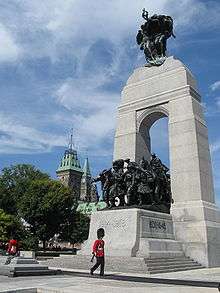 |
| Connaught Building [12] | 1916 (completed) | 1990 | Ottawa 45°25′36″N 75°41′41″W / 45.426562°N 75.694669°W |
A testament to Wilfrid Laurier’s commitment to enhance the architecture in Canada's capital; one of the best works of David Ewart, the Chief Dominion Architect from 1896 to 1914 |  |
| Diefenbunker / Central Emergency Government Headquarters [13] | 1959 (completed) | 1994 | Ottawa 45°21′06″N 76°02′50″W / 45.35167°N 76.04722°W |
An underground 4-storey bunker, capable of withstanding a near-hit from a nuclear explosion, built to shelter key Canadian political and military personnel in the event of a nuclear war, now a museum | |
| Earnscliffe [14] | 1857 (completed) | 1960 | Ottawa 45°26′15″N 75°41′56″W / 45.437378°N 75.698912°W |
A house overlooking the Ottawa River, once the home to Canada's first Prime Minister, Sir John A. Macdonald, now the official residence of the British High Commissioner to Canada | |
| Former Archives Building [15] | 1906 (completed) | 1990 | Ottawa 45°25′50″N 75°41′55.89″W / 45.43056°N 75.6988583°W |
The home of the Public Archives of Canada from 1906 to 1967, and the Canadian War Museum from 1967 to 2005, this building was constructed as part of Prime Minister Sir Wilfrid Laurier’s efforts to transform Ottawa from a lumber town into a capital city with requisite cultural and civic amenities and architecture | |
| Former Geological Survey of Canada Building [16] | 1863 (completion of the oldest part of the building) | 1955 | Ottawa 45°25′35.45″N 75°41′38.16″W / 45.4265139°N 75.6939333°W |
Among the oldest government buildings in the capital, the building was the first Ottawa home of the Geological Survey of Canada; the building was also used to host the inaugural exhibit of the Canadian Academy of Arts in 1880 (the genesis of the collection of the National Gallery of Canada), and to display the Geological Survey's museum collections (which served as the foundation of the Canadian Museum of Nature) | |
| Former Ottawa Teachers' College [17] | 1875 (completed) | 1974 | Ottawa 45°25′11.97″N 75°41′27.35″W / 45.4199917°N 75.6909306°W |
A nationally significant example of the Gothic Revival style in an eclectic design; the building served as a normal school until 1974, and now serves as a wing of Ottawa City Hall | |
| John R. Booth Residence [18] | 1909 (completed) | 1990 | Ottawa 45°25′00″N 75°41′33″W / 45.416762°N 75.692480°W |
Built for lumber baron John R. Booth, the house is a nationally significant example of the Queen Anne Revival style in domestic architecture | |
| Langevin Block [19] | 1889 (completed) | 1977 | Ottawa 45°25′25.23″N 75°41′49.42″W / 45.4236750°N 75.6970611°W |
One of the finest examples of Second Empire style office building architecture in Canada, the Langevin Block was the first purpose-built office building erected by the federal government outside the boundaries of Parliament Hill; currently serves as home to the Prime Minister’s Office and the Privy Council Office | |
| Laurier House |
1878 (completed) | 1956 | Ottawa 45°25′40″N 75°40′41″W / 45.4277°N 75.6781°W |
As Canada did not have official residences for elected officials until 1950, this house was the home of Sir Wilfrid Laurier and then William Lyon Mackenzie King during the periods when each was leader of the Liberal Party of Canada; Laurier and King each served both as Prime Ministers and Leaders of the Opposition while living in this home |  |
| Maplelawn & Gardens [21] | 1834 (completed) | 1989 | Ottawa 45°23′17.63″N 75°45′43.02″W / 45.3882306°N 75.7619500°W |
A rare example of an early 19th-century country estate in Canada and an excellent example of the British classical style; the gardens are the best preserved of the few surviving examples of 19th-century walled gardens in Canada | 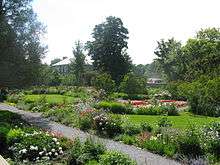 |
| National Arts Centre [22] | 1969 (completed) | 2006 | Ottawa 45°25′23″N 75°41′38″W / 45.4230°N 75.6938°W |
Built to commemorate the Canadian Centennial and designed in the shape of hexagons, the centre heralded Canada's cultural and architectural achievements in the second half of the 20th century; also a component of the Confederation Square National Historic Site of Canada | |
| Notre-Dame Roman Catholic Basilica [23] | 1842-1897 (construction) | 1990 | Ottawa 45°25′47″N 75°41′47″W / 45.42971°N 75.69646°W |
A Basilica prominently located on Sussex Drive, whose twin towers mark the entrance to Lower Town, one of Ottawa’s earliest neighbourhoods; it is considered an exceptional example of Gothic Revival architecture in Canada |  |
| Parliament Buildings [24] | 1865 (West Block completed), 1866 (East Block), 1876 (Library of Parliament), 1920 (Centre Block) | 1976 | Ottawa 45°25′29″N 75°41′57″W / 45.4248°N 75.6992°W |
The seat of the Parliament of Canada in a striking location on a hill above the Ottawa River; an important symbol serving as the physical embodiment of the Canadian government and federation |  |
| Public Grounds of the Parliament Buildings [25] | 1875 (initial completion) | 1976 | Ottawa 45°25′29″N 75°41′57″W / 45.424807°N 75.699234°W |
The focal point for national celebrations in Ottawa; the grounds were originally designed by Calvert Vaux, and since supplemented by 18 monuments and memorials |  |
| Rideau Canal |
1837 (completed) | 1925 | Ottawa to Kingston 45°25′33″N 75°41′50″W / 45.42583°N 75.69722°W |
Built for the British government by Lieutenant-Colonel John By as a defensive work in the event of war with the United States, the still-functioning canal is the best preserved example of a 19th-century slack water canal in North America, with most of its original structures intact; a World Heritage Site and a unique historic landmark in the central core of Ottawa |  |
| Rideau Hall and Landscaped Grounds [27] | 1838 (completion of original villa) | 1977 | Ottawa 45°26′39.73″N 75°41′9.5″W / 45.4443694°N 75.685972°W |
The official Ottawa residence of the Governor General of Canada and the Canadian monarch; excellent example of the transposition of the natural style of the English country estate to Canada | 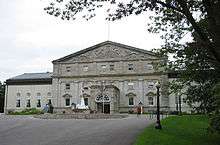 |
| Royal Canadian Mint [28] | 1908 (completion of main building) | 1979 | Ottawa 45°25′52.14″N 75°41′57.36″W / 45.4311500°N 75.6992667°W |
Representative of the federal government’s approach to using the Tudor Gothic architectural style to create a distinctive identity in Canada's capital; the construction of this building, combining a mint and a refinery for gold produced by Canadian mines, symbolized the patriation of control over Canada’s currency from Britain | |
| Victoria Memorial Museum [29] | 1911 (completed) | 1990 | Ottawa 45°24′46″N 75°41′20″W / 45.41266°N 75.68875°W |
Built to house Canada's first national museum, the building originally served as the home of the National Gallery of Canada and of the geological and natural history collections of the Geological Survey of Canada, and then served as the temporary premises of the Parliament of Canada from 1916 to 1922 when the original Centre Block was destroyed by fire; now the home of the Canadian Museum of Nature | |
See also
| Wikimedia Commons has media related to National Historic Sites of Canada in Ottawa. |
References
- ↑ Ottawa, Carp, Directory of Designations of National Historic Significance of Canada
- ↑ Ottawa, National Historic Sites of Canada - administered by Parks Canada
- ↑ Rideau Canal, Directory of Designations of National Historic Significance of Canada
- ↑ Aberdeen Pavilion. Canadian Register of Historic Places.
- ↑ Beechwood Cemetery. Canadian Register of Historic Places.
- ↑ Billings House. Canadian Register of Historic Places.
- ↑ Central Chambers. Canadian Register of Historic Places.
- ↑ Central Experimental Farm. Canadian Register of Historic Places.
- ↑ Château Laurier. Canadian Register of Historic Places.
- ↑ Hotel History, Fairmont Château Laurier - Fairmont Hotels
- ↑ Confederation Square. Canadian Register of Historic Places.
- ↑ Connaught Building. Canadian Register of Historic Places.
- ↑ Diefenbunker / Central Emergency Government Headquarters. Canadian Register of Historic Places.
- ↑ Earnscliffe. Canadian Register of Historic Places.
- ↑ Former Archives Building. Canadian Register of Historic Places.
- ↑ Former Geological Survey of Canada Building. Canadian Register of Historic Places.
- ↑ Former Ottawa Teachers' College. Canadian Register of Historic Places.
- ↑ John R. Booth Residence. Canadian Register of Historic Places.
- ↑ Langevin Block. Canadian Register of Historic Places.
- ↑ Laurier House. Canadian Register of Historic Places.
- ↑ Maplelawn & Gardens. Canadian Register of Historic Places.
- ↑ National Arts Centre. Canadian Register of Historic Places.
- ↑ Notre-Dame Roman Catholic Basilica. Canadian Register of Historic Places.
- ↑ Parliament Buildings. Canadian Register of Historic Places.
- ↑ Public Grounds of the Parliament Buildings. Canadian Register of Historic Places.
- ↑ Rideau Canal. Canadian Register of Historic Places.
- ↑ Rideau Hall and Landscaped Grounds. Canadian Register of Historic Places.
- ↑ Royal Canadian Mint. Canadian Register of Historic Places.
- ↑ Victoria Memorial Museum. Canadian Register of Historic Places.